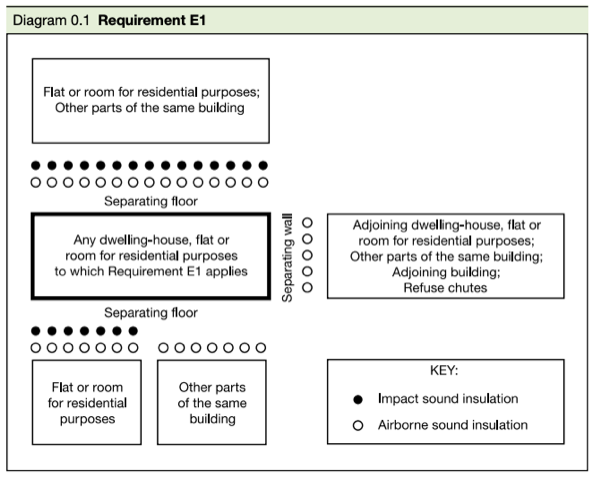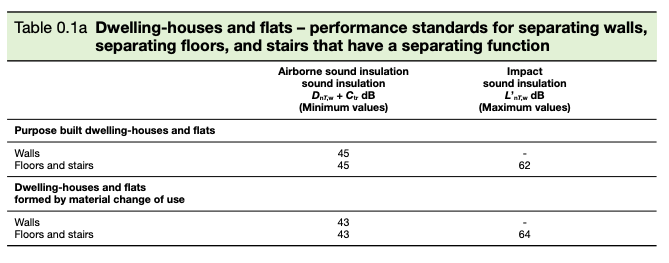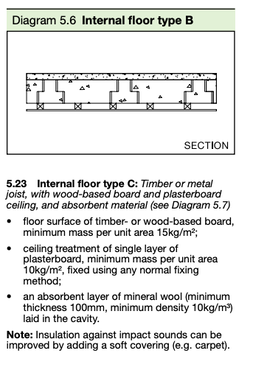Shape Divider - Style tilt
Sound Testing to New-Builds
Please note: our company does not provide sound testing, this is an information page only.
Regulations & Testing Process:
A brief explanation on Sound testing according to E1
Part E of the building regulations is called Resistance to the Passage of Sound (which can be downloaded here), and relates to the way in which partition walls and floors between dwellings should cope with the passage of noise. A developer is able to meet the standards either by building according to the Robust Detail specification or by having an on site test using specialist equipment.
To summarise Part E1 of the Building Regulations, there are two ways that noise is tested: The first is impact, where a ’tapping machine’ is placed on the floor of the apartment above and the noise is recorded below (discounting background noise). The second is airborne which places speakers in the larger room and records the dB of white noise in the smaller room (again, discounting background noise).
The below diagram taken from the Building regulations explains the two options: where Impact sound (black dots) using a tapping machine are used on the flooring and Airborne sound (white dots) is carried out using amplifiers between the walls and floors.
To summarise Part E1 of the Building Regulations, there are two ways that noise is tested: The first is impact, where a ’tapping machine’ is placed on the floor of the apartment above and the noise is recorded below (discounting background noise). The second is airborne which places speakers in the larger room and records the dB of white noise in the smaller room (again, discounting background noise).
The below diagram taken from the Building regulations explains the two options: where Impact sound (black dots) using a tapping machine are used on the flooring and Airborne sound (white dots) is carried out using amplifiers between the walls and floors.
The process do to these tests are very specific, and the data collected then is calculated to determine whether it is a pass or fail according to building regulations.
All new builds have to pass the test which is provided in the other screenshot (table) below. It basically means the calculation for acceptable standards needs to achieve more than 45bd for airborne noise (using amplifiers) and no more than 62dB impact noises (the test you would need where a tapping machine is put on the floor and noise recorded underneath).
All new builds have to pass the test which is provided in the other screenshot (table) below. It basically means the calculation for acceptable standards needs to achieve more than 45bd for airborne noise (using amplifiers) and no more than 62dB impact noises (the test you would need where a tapping machine is put on the floor and noise recorded underneath).
The pass rate for the UK is lower than the other counties. Scotland has different regulations and requires a score over 56db just for a point of reference compared to 45dB in the UK. . Sometimes a test result comes close to the wire of 45dB will be acceptable in the eyes of Building Regulations, but it is likely to be noisy!
Sound Testing misconceptions
|
The key point to make about testing according to E1 of the building regulations is that it is only between two dwellings. It therefore is not suitable for homeowners of new build houses that e.g. have creaking floorboards from their own bedroom to downstairs lounge (as the most common complaint we hear about!). This is because the building regulations to do not have a pass rate for this from a field testing point of view. The detail of how walls and floor types should be constructed is specified in Section 2 of part E. An example image of this is shown here.
Also when carrying out the field tests, they are done per property type. So on a large site, the builder will not have to carry out the test on every property with an adjacent property (town house, semi detached, apartment etc). They rather just need to carry out this test on each grouping type and assume the others of the same grouping will be the same result. We hope this article has been useful. If you are looking for an acoustic / noise testing company for your new build, we recommend any local UKAS accredited company. |
Shape Divider - Style tilt
|
|
Office 1, Izabella House, 24-26 Regent Place, Birmingham, B1 3NJ
|




